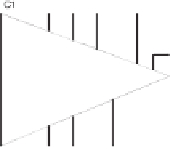Biomedical Engineering Reference
In-Depth Information
Figure 3.9
In this EEG amplifier, an extra optoisolator is used to introduce offset automatically to pass bipolar signals and to linearize the
response of the isolation amplifier. IC3B drives the LEDs of optoisolators IC4 and IC5. The phototransistor in IC4 is used to set the invert-
ing input of IC3B such that the LED is driven to a point that balances the signal at IC3's noninverting input. When the phototransistor in IC5
is not illuminated, its collector is pulled up to the nonisolated positive supply rail by R21. However, as signals cause IC3B to drive the LED,
the phototransistor pulls the collector towards the nonisolated negative supply rail.
the di
ff
erential ampli
fi
er implemented by IC1A. This di
ff
erential ampli
fi
er has unity gain
and is used to add an o
ff
set voltage that is set via potentiometer R3. The input signal is then
low-pass
filtered through R6 and C6 to the dc-65 Hz modulation bandwidth, which can be
supported by the pulse-width modulator implemented around IC1B. The pulse-train output
from the pulse-width modulator drives an LED inside optocoupler IC2 via transistor Q1.
The Optek OPI1264 optoisolator used in this circuit was selected because it has a very
respectable 10-kV isolation rating (although its UL
fi
file rates it at 3500 V ac for 1 minute).
At the phototransistor end of IC2, the light pulses generated by the LED are received
and converted into a replica of the original pulse train through the
RC
high-pass
fi
filter
formed by R13 and C8. The circuit centered on IC3A acts as a pulse-train demodulator to
reconstruct the original modulating signal, which, depending on the characteristics of the
input signal, may have an o
fi
ff
set. Finally, the low-pass
fi
filter implemented around IC3B
removes any remnants of the pulse train's carrier.


































































































































































































































































































































Search WWH ::

Custom Search